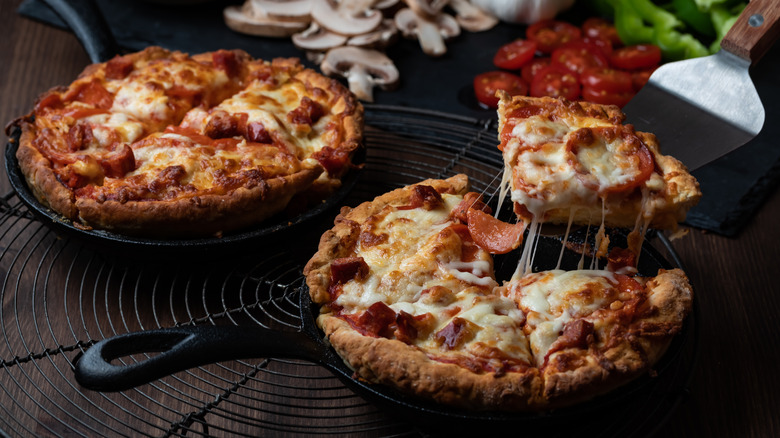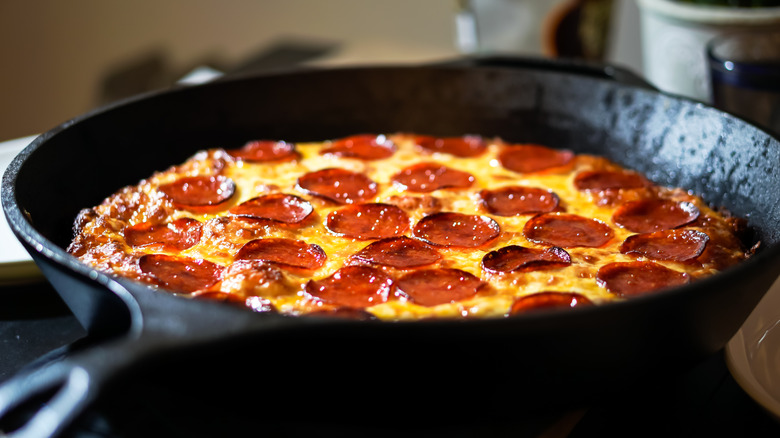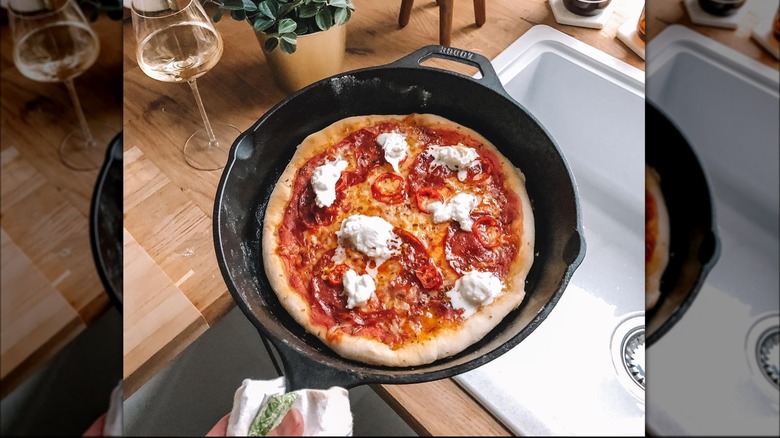Expert Tips To Avoid Burning Cast Iron Skillet Pizza
If you're perpetually trying to get your homemade pizza to taste like the restaurant's, using a cast iron skillet could help get your pie to that perfect balance of fluffy, crispy, and chewy. While a pizza stone is great for making thin-crust 'za, and the grill breathes new life into frozen pizza, the cast iron skillet is your best friend for making thick-crust pies. It transfers heat evenly, caramelizes the bottom of the crust, and because of its depth, lets you pile on much more of your favorite toppings.
If you've ever made pizza, you'll know that a great pie is the result of many small things done correctly (and a few chef's tricks for good measure). With thick-crust pizza, the hardest part is ensuring that the top and bottom of the pizza cook to perfection and are ready at the same time, where neither ends up burnt. In an exclusive chat with Foodie, Nicole Bean, Owner of Pizaro's Pizza Napoletana in Houston, took us through the ins and outs of how to cook a perfect deep-dish pizza on a cast iron skillet. A common pitfall is burning and overcooking while trying to get the perfect crust, so we've taken a closer peek at how to avoid it — from signs to look for that tell you when the pizza is at its crispy best to the pros and cons of using a premade crust and pre-cooked ingredients. You can find more pizza goodness on the pizzeria's Instagram, @pizaros_pizza.
Get a crispy crust and melted cheese without burning or overcooking
The different levels of heat that the top and bottom of the pizza require, combined with the additional cooking time needed for the thicker crust of the skillet pizza, means that getting the perfect crust without overcooking the toppings is a bit of a balancing act. While cast iron helps cook the bottom faster, if you leave the pizza in the oven too long waiting for it to crisp up, you risk burning and drying out the top. Using a pre-made crust or pre-cooking your toppings a little can help balance things out, but Bean warns that this could lead to a soggy crust or burnt toppings by the end. "Tin foil can help prevent burning in some cases, but usually a lower temperature for longer will prevent that," she advises. Covering the skillet with foil for the initial part of the bake can also help retain moisture and ensure the cheese doesn't dry out too much.
Thus, unlike a Neapolitan that requires scorching temperatures and a short cooking time, it's best to give the skillet pizza a longer bake at a lower heat. However, this also means that you'll need to check from time to time (but not too often) to see if the crust is done. Bean recommends looking for a golden brown color with some dark caramelization on the edges and the sides of the pie. This is the sign that your pizza is perfectly cooked.
Watch out for these mistakes when making cast iron skillet pizza
According to Bean, one of the most common mistakes that home cooks make while cooking pizza on a cast iron skillet is not using enough oil on the pan. In extreme cases, this can have disastrous consequences, with the crust ending up stuck to the pan's bottom. You can use olive oil, especially if you like the taste of it. Alternatively, cooking spray or any neutral cooking oil also works. While you don't need it sloshing around, make sure to add a generous layer of whichever oil you're using to the pan and use your hand to coat the bottom evenly, paying special attention to the edges. The oil also ensures that your crust gets an even, crispy golden brown finish.
The other pitfall to watch out for is removing your pizza too soon from the oven. You may be concerned about overcooking the top of the pizza, but with the aforementioned tin foil covering, you can rest easy knowing your toppings are safe from the gas or heating elements. Be patient and allow the crust to cook through and get crisp. This usually takes between 15 and 20 minutes, but can even take up to 25 minutes. Given the long cooking time, skillet pizza isn't the best option for a pizza party. Fortunately, it's easy enough to calculate how many pizzas you need for a large group if go with the order-in option.


